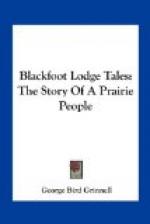Necklaces and ear-rings were worn by all, and were made of shells, bone, wood, and the teeth and claws of animals. Elk tushes were highly prized, and were used for ornamenting women’s dresses. A gown profusely decorated with them was worth two good horses. Eagle feathers were used by the men to make head-dresses and to ornament shields and also weapons. Small bunches of owl or grouse feathers were sometimes tied to the scalp locks. It is doubtful if the women ever took particular care of their hair. The men, however, spent a great deal of time brushing, braiding, and ornamenting their scalp locks. Their hair was usually worn in two braids, one on each side of the head. Less frequently, four braids were made, one behind and in front of each ear. Sometimes, the hair of the forehead was cut off square, and brushed straight up; and not infrequently it was made into a huge topknot and wound with otter fur. Often a slender lock, wound with brass wire or braided, hung down from one side of the forehead over the face.
As a rule, the men are tall, straight, and well formed. Their features are regular, the eyes being large and well set, and the nose generally moderately large, straight, and thin. Their chests are splendidly developed. The women are quite tall for their sex, but, as a rule, not so good-looking as the men. Their hands are large, coarse, and knotted by hard labor; and they early become wrinkled and careworn. They generally have splendid constitutions. I have known them to resume work a day after childbirth; and once, when travelling, I knew a woman to halt, give birth to a child, and catch up with the camp inside of four hours.
As a rule, children are hardy and vigorous. They are allowed to do about as they please from the time they are able to walk. I have often seen them playing in winter in the snow, and spinning tops on the ice, barefooted and half-naked. Under such conditions, those which have feeble constitutions soon die. Only the hardiest reach maturity and old age.




